B-29 Superfortress "Enola Gay"
Of the 3,970 B-29s built, few have been preserved, restored, and put on static display. A total of only about 22 complete B-29 airframes are currently on display in the United States.
In wartime, the B-29 was capable of flight up to 31,850 feet at speeds of 350 mph. Designed as a high-altitude daytime bomber, the B-29 flew more low-altitude nighttime incendiary bombing missions.
In December 1943 U.S. Army Air Forces leadership committed the Superfortress to Asia, where its great range made it particularly suited for the long over-water flights against the Japanese homeland from bases in China.
The first B-29s arrived at Allied airfields in India and China in April 1944. Flying from India, B-29s first saw combat on June 5, 1944, when 98 planes struck Bangkok. A month later, B-29s flying from Chengdu, China struck Yawata, Japan in the first raid on the Japanese home islands since the Doolittle Raid in 1942.
During the last two months of 1944, B-29s began operating against Japan from the islands of Saipan, Guam and Tinian. As many as 1,000 Superfortresses at a time bombed Tokyo, destroying large parts of the city.
The Silverplate Project ... Deliver the Atomic Bomb over Japan
 Col. Paul Tibbets, Jr. |
Late in 1944, Army Air Forces leaders selected the Glenn L. Martin Company assembly line to produce a squadron of B-29s codenamed "Silverplate". Martin modified these Superfortresses by removing all gun turrets except for the tail position, removing armor plate, and installing Curtiss electric propellers.
The AAF assigned 15 Silverplate Superfortresses to the 509th Composite Group commanded by Colonel Paul W. Tibbets, Jr. As the Group Commander, Tibbets had no specific aircraft assigned to him as did the mission pilots. He was entitled to fly any aircraft at any time.
Enola Gay was personally selected by Colonel Tibbets on May 9, 1945, while still on the assembly line.
The Move to Tinian and Final Bombing Plans
The Japanese Ushi Point airfield on the Pacific island of Tinian in the Marianas had fallen to United States forces on July 26, 1944. The capture of Tinian was a key part in the plan to provide a closer base for the U.S. forces to bomb Japan. Still, the distances to Japan were great, as the island lies at 1,500 miles south of Tokyo. Work on restoring and improving the airfield to support Superfortresses began immediately by Army Seabees.
Shaped like Manhattan in New York, the Army engineers named the base facilities with names like Broadway and 42nd Street. Its four parallel runways at North Field were 8,500' in length and marked as "A", "B", "C" and "D" (from north to south). Hardstands were constucted to park and maintain 265 Superfortresses. Two additional runways were built at West Field (today, known as Tinian International Airport).
In 1945, Tinian became the largest airfield in the world, occupied by 40,000 U.S. troops.
By May of 1945, the 509th had moved to Tinian. It was was assigned an area near the airfield on the north end of Tinian, several miles from the main installations where the other groups were assigned. The 509th aircraft almost always used runway "A" and the aircraft were parked away from the other groups on the north side of the runway.
On July 26, 1945, the cruiser Indianapolis dropped anchor off Tinian and unloaded a 15-foot wooden crate. Inside was the atomic bomb, complete except for a second unit of uranium that a B-29 later delivered. Four days after departing Tinian, Indianapolis was sunk by a Japanese submarine.
By August of 1945, plans for the atomic bombing missions were finalized. Seven Superfortresses would take part in each bombing run: the primary (carrying the bomb), a standby, a photo plane, one with scientific instruments to measure the blast, and three others that would scout ahead. Bombing would be visual, rather than by radar. Possible target cities included Hiroshima, Kokura, Niigata, and Nagasaki.
The Day of the First Atomic Bomb Drop: August 6, 1945
Colonel Tibbets later piloted the B-29 "Enola Gay" (Serial Number 44-86292) on August 6, 1945, and dropped "Little Boy" over Hiroshima, Japan. The secondary targets had been Kokura and Nagasaki.
He named the B-29 that he flew on August 6 the "Enola Gay" after his mother, Enola Gay Tibbets. In the early morning hours, just prior to the August 6, 1945 mission, Tibbets had a young Army Air Forces maintenance man, Private Nelson Miller, paint the name just under the pilot's window.
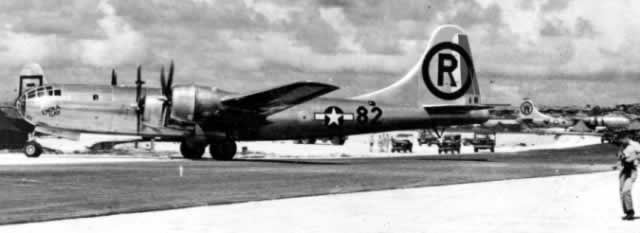 "Enola Gay" parked on tarmac after Hiroshima atomic bomb flight |
The mission to Hiroshina had lasted 12 hours and 13 minutes; Enola Gay landed without incident after the flight at Tinian Island.
President Truman announced the next day, on August 7, 1945, that the bomb had been dropped on Hiroshima.
The Day the Second Bomb Dropped: August 9, 1945
A second B-29 Superfortresses flight, with Bockscar as the primary aircraft, was scheduled to bomb Kokura, Japan on August 11, 1945. But weather forced a change in the date to August 9. This second nuclear bomb run was to further decimate Japan's military structure, but also to demonstrate that the U.S. had an arsenal of nuclear weapons.
The second atomic bomb, "Fat Man," was dropped on Nagasaki, Japan by the B-29 "Bockscar".
On August 14, 1945, the Japanese accepted Allied terms for unconditional surrender. The War against the United States, begun by the Japanese when Japan attacked Pearl Harbor on December 7, 1941, was ended.
Enola Gay After World War II
On November 6, 1945, the "Enola Gay" was flown back to the 509th's new base at Roswell Army Air Field, New Mexico. The decision was made to preserve the aircraft, and on July 24, 1946, the aircraft was flown to Davis-Monthan Air Force Base, Arizona, in preparation for storage.
The following month the title to the aircraft was transferred to the Smithsonian Institution and the B-29 was removed from the USAAF inventory. From 1946 to 1961, the Enola Gay was put into temporary storage at a number of locations across the country, including Pyote Army Air Field in Texas (see photo below).
Today, "Enola Gay" is on display at the Udvar-Hazy Center of the Smithsonian Museum at Dulles Airport in Washington, D.C. (see photos below).
Other Surviving B-29 Superfortress Aircraft
click to see a complete list of surviving B-29s, their names, serial numbers, and locations
Photographs of the B-29 Superfortress "Enola Gay"
B-29 Superfortress "Enola Gay" at the Udvar-Hazy Center at Dulles Airport in Washington, D.C. |
 |
Front fuselage view of the B-29 Superfortress "Enola Gay" at the Udvar-Hazy Center |
 |
B-29 Superfortress "Enola Gay" at the Smithsonian Institution's Udvar-Hazy Center in Washington, D.C. |
 |
Cockpit area of the B-29 Superfortress "Enola Gay" |
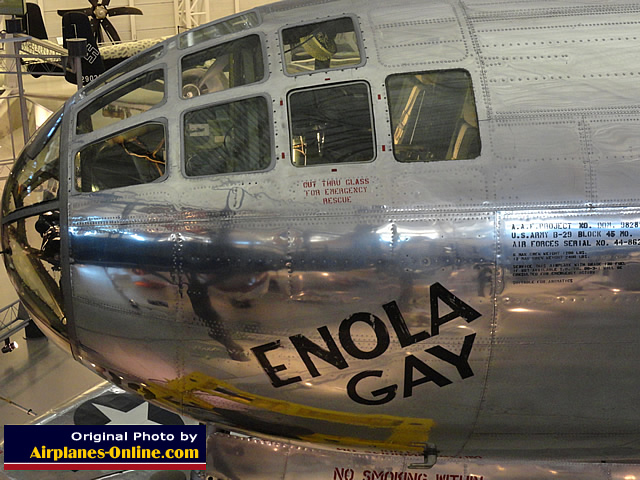 |
Front view of the B-29 Superfortress "Enola Gay" |
 |
B-29 Enola Gay Photos During World War II
Boeing B-29 Superfortress "Enola Gay" |
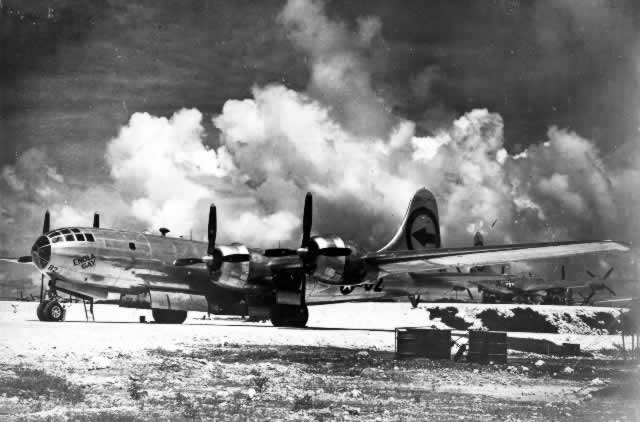 |
Boeing B-29 Superfortress "Enola Gay" landing after the Hiroshima bombing run in August of 1945 |
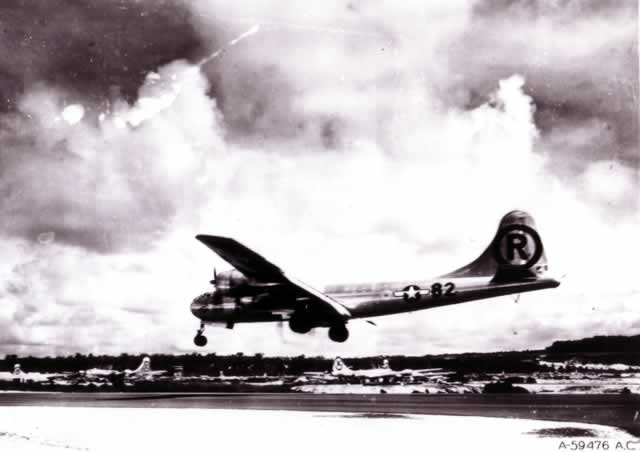 |
"Enola Gay" parked on tarmac after Hiroshima atomic bomb flight |
 |
B-29 Superfortress "Enola Gay" in storage at Pyote Army Air Field in Texas post-WWII (Rattlesnake Bomber Base Museum archives) |
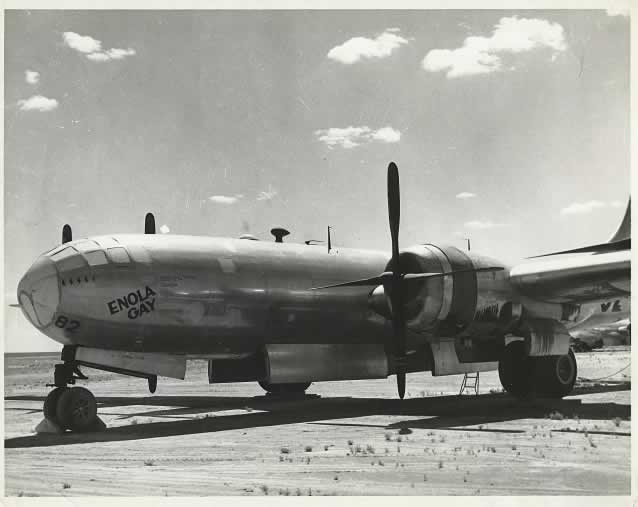 |
More about the B-29 Superfortress |
|||||

